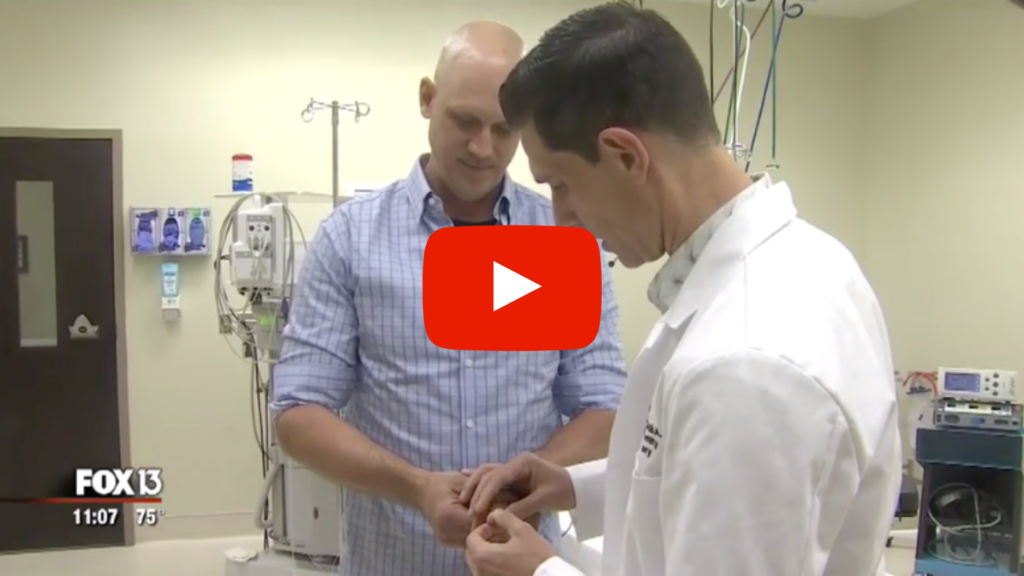First Successful Custom 3D Printed Finger Bone Implant in the Country
When ironworker Robert Smith had his middle finger crushed by a heavy steel beam, he was left with a finger that was basically useless, with little skeletal support. And this made him unable to do his job as an iron worker since he needs to grip and pinch materials in his work.
Dr. Daniel Penello, a surgeon with Alexander Orthopaedic Associates, considered a wide range of options for helping Mr. Smith and decided to try something that had never been done before in the United States. Working with Additive Orthopaedics, which specializes in medical 3D printing, Dr. Penello created a custom finger bone implant to replace the bone that had been crushed beyond repair.
The First of its Kind
The challenge was that no finger-bone implant of this type had ever been made, let alone successfully used in the past. But with 3D printing, working from a CT scan of Mr. Smith’s opposite middle finger, Dr. Penello was able to work through multiple iterations of the implant over a five-month period until he got to the exact specifications that would work. As Dr. Penello’s mentor, Dr. Robert B. Salter, frequently said, “Trifles make perfection, but perfection is no trifle.”
Mr. Smith has seen continual improvement in his finger’s functionality since the surgery was performed May 30. He’s now doing physical therapy to restore the full use of his hand – something that wouldn’t have been possible without the ability to create a custom solution with 3D technology.

3D Printing and Orthopaedic Surgery
The successful operation is an example of the growing impact that 3D printing is making on the orthopaedic profession and on Alexander Orthopaedic Associates’ work. By reducing the time and cost of making custom implants, the technology allows surgeons to refine a design until they get it just right – dramatically expanding the potential uses of implants in orthopaedic surgery.
“It’s extremely difficult to create an implant that will have the strength and long-term stability needed for full functionality in such a small area within a finger,” Dr. Penello said. “My primary concern was our ability to develop an implant that would fit anatomically while being strong enough to withstand the tremendous forces it would be exposed to during any pinching, gripping or lifting activities.
“That’s why no one has ever been able to use an implant in this way before. We’re so excited to see Mr. Smith regain use of his finger, and to help him get his life back.”
As Dr. Penello worked through iterations of the 18-millimeter finger bone implant for Mr. Smith, the partnership with Additive Orthopaedics, a Little Silver, New Jersey-based medical 3D printing specialist, was critical.
The process worked like this: Dr. Penello would get a new version of the implant, try it in a digital simulation of the surgery, and then recommend modifications to make it more durable, enhance its stability and facilitate surgical implantation. The final implant was made with a specially designed surgical-grade metal, making it both light and extremely strong.
Mr. Smith, who suffered the accident in November 2017, plans to go back to work in the next few months. “After fearing that I had lost use of my finger forever, it’s so exciting to get full functionality back,” said Mr. Smith, 38, of St. Petersburg. “Dr. Penello gets major credit for his willingness to take on the challenge, and for taking the time and care to create a solution that would work for me.”
After seeing the post-op x-ray of the implant in his finger, “I was blown away by Dr. Penello's extreme level of skill and precision,” Mr. Smith said, “and I can confidently say that he is, without question, one of the top orthopaedic surgeons in the world today. I'd also like to give major credit to Additive Orthopaedics for the cutting-edge technology that allowed this to be possible, and I'm deeply grateful to them for it."
3D Printing and Alexander Orthopaedics
We're proud to be a national leader in using 3D printing in orthopaedic surgery.
And while custom 3D printing isn’t needed to create implants for routine surgeries, it’s growing in popularity for more complex, challenging situations. On a broader scale, this type of work is another sign that our practice sets itself apart by providing the highest quality care in a cost-effective manner. “It’s a win-win scenario for everyone involved,” Dr. Penello said.

